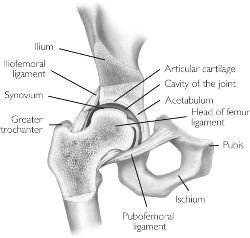The hip joint is a deep ball and socket joint surrounded by multiple layers of muscle and ligaments that move the leg in different directions allowing us to walk, run, jump and hop.
When the muscles surrounding the joint are not working efficiently or as optimally as they should be, it can create issues with the joints above and below the hip. Quite often, lower back pain is associated with issues in either the hip joint itself or in the muscles that cross the joints.
So what happens when the pain is in the joint itself? Pain within the joint is generally associated with conditions including osteoarthritis, osteoporosis or tears within the joint cartilage. When the pain becomes too unbearable or there is a fracture a total hip replacement occurs.

Have you had or do you require a hip replacement?
TWO TYPES OF SURGERIES:
1. Total Hip Replacement (THR)
A THR is a surgical removal of the head and neck of the femur and replacement of the acetabulum. A prosthetic replica of the head of the femur will be attached to the body of the femur and a plate will be attached to the acetabulum.
2. Partial Hip Replacement (PHR)
Focuses on the replacement of the neck of the femur that has been fractured and self-healing is not an option.
Who can have a THR?
· Severe Osteoarthrits
· Severe Hip Fracture
· Damage to the Acetabulum
· Avascular Necrosis
· Rheumatoid Arthritis
There are THREE different approaches to performing a THR: anterior, lateral and posterior. The biggest difference between the three approaches are the amount of soft tissue (muscle/ligament) damage occurring during the surgery. The anterior approach is where the surgeon goes through the front part of the body. This method is considered least invasive and damaging for the soft tissue surrounding the joint. The posterior approach on the other hand is the most preferred method as it provides the best view of the joint itself.
To ensure the best possible outcome for rehabilitation, it is important to be as strong as possible prior to surgery. If you would like to know more about how you can become stronger, we advise contacting your local Exercise Physiologist for helpful tips and tricks.




